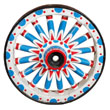Ringling Bros. Circus Bell Wagon
by Fred Dahlinger, Jr.
(1) The best available evidence suggests that the bell wagon was the first major parade wagon constructed especially for the Ringling Bros. World’s Greatest Shows. Following a typical circus practice, the Ringlings purchased their first wagons second hand from fellow showmen. The construction of the wagon marked a significant change in Ringling policy and denoted one step in the path which led to their eventual domination of the circus business. Within a decade after the bell wagon’s construction the Ringlings became generators of surplus and second hand assets which were peddled to lesser showmen.
The designer of the Ringling bell wagon departed from the box body precedent, creating an open framework design which accentuated the bells instead of the carved housing. This was made feasible by the size of the bells, their scale being sufficiently large to prevent them from being obscured in the overall design. Based upon documents surviving from later transactions, it is likely the Ringlings acted as their own general contractor for the wagon, parceling out various portions of the new vehicle to trade specialists. A triumvirate of Wisconsin businesses were selected for the work, with one firm furnishing the bells and their supports, another constructing the wagon and a third supplying the carvings to decorate the vehicle. Surprisingly, the final result held together very nicely from an aesthetic point of view.
A sign on the side of the bell framework announced that the Centennial Bell Foundry of Milwaukee, Wisconsin had produced the bells. Although the name G. Campbell & Sons is given, Milwaukee directories indicate the firm was actually Campbell, Gardiner & Sons. The principals, Henry R. Campbell and George G. Gardiner, operated a bell and iron foundry and machine shop at 238-256 Oregon Street. The Centennial name probably originated with the shop’s opening for business in 1876, the nation’s centennial year.
The Sauk County Democrat of February 25, 1892 reported that the bell apparatus had arrived in Baraboo three days earlier, and that they were being placed in storage at the Ringling quarters until the wagon was built. The Democrat of March 3, 1892 announced the bells were out of tune and would have to be recast. Whether this action was actually undertaken is not known.
The bells ranged from nineteen to thirty six inches in diameter at the bottom, and from fifteen to twenty eight inches high. Although it is the only one mounted in a yoke stand, the topmost bell did not rotate, but was fixed in position, as were the other bells. They were sounded by a clapper which was activated by a lever at the rear mounted console. The small number of bells, nine, limited the player to only the simplest of tunes. The 1894 Ringling route book indicates that “The [My?] Old Kentucky Home” and “Nearer My God to Thee” were played, in addition to anthems, hymns and popular airs. In 1941 correspondent of the Billboard reported that he had played “Rock of Ages,” “Greenland’s Icy Mountains” and “Dixie” on the bell wagon in 1893. Al Ringling alledgedly liked the playing of church tunes on the bells.
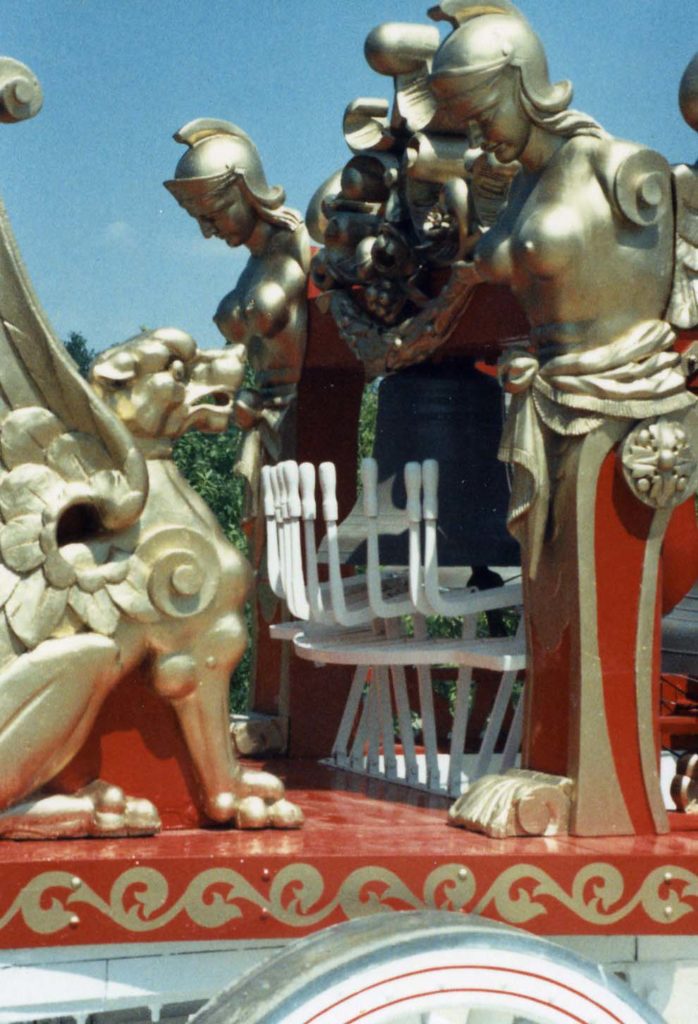 ( 1985 – Marv Gauger photo courtesy of Stephen T. Flint )
( 1985 – Marv Gauger photo courtesy of Stephen T. Flint )
Except for six big wagons built at Cincinnati in 1903, all of the wagons used by the Ringling show were constructed by their cousins, the Moellers of Baraboo. The business dealings between these two firms spanned over four decades, a tribute to the quality vehicles which rolled out of their shop on Baraboo’s Third Avenue. Henry C. Moeller, Sr. (1828-1908) founded the firm in 1856, setting up his wagon shop in connection with a blacksmith shop owned by a cousin. G. C. Gollmar. In 1872 the business was destroyed by fire, but it was rebuilt and back in operation by Moeller was later assisted in the business by his two sons, Henry C. Jr. (18687-1957) and Corwin G. (7-1946). In 1891 the name of the firm became Moeller & Sons to denote their contributions.
According to notes made by Henry Jr., the Moellers entered the circus wagon business in a small way in 1884, the first year of the Ringling circus. These early wagons were more on the order of heavy duty carriages than circus wagons, but by 1890 the Moellers were repairing full sized railroad show wagons.
On February 25, 1892 the Sauk County Democrat reported that nine men in the Moeller shop were working on Ringling wagons. One of the vehicles under construction was a hippo den, the first of three the Ringlings owned. Also in the shop at the time was the bell wagon, but curiously the Baraboo papers did not mention it.
In a 1949 communication with Richard E. Conover, Henry Moeller, Jr. recalled that Keem Repski of Milwaukee furnished the carvings for the bell wagon. The Milwaukee directories of the 1890’s do not list an individual or business with this name and it is our belief that the name Moeller spoke or scribbled was a corruption of the names Kuehns and Papke, the owners of the Milwaukee Ornamental Carving Co. (MOCC), the firm which usually supplied the carvings applied to Ringling wagons. The MOCC was founded in 1886 primarily to do interior and exterior decoration in both wood and plaster for homes and businesses. Their proximity to Baraboo made them an obvious choice to do the carvings for Ringling vehicles being built by the Moellers.
Carl V. Kuehns was the artistic member of the firm, and Otto H. Papke (1856-1943) handled the accounting and financial aspects of the business. Originally there was a third partner. Joseph Grauvogel, but he dropped out by 1896. When the wood carving business evaporated, the firm concentrated on its plastering work, decorating such Milwaukee showplaces as the Oriental, Pabst, Palace and Wisconsin Theatres. The firm was dissolved shortly after Papke’s death in 1943.
The carvings for the bell wagon were among the earliest carvings supplied by MOCC to the Ringlings. During the next two decades the MOCC artisans furnished the carvings for a multitude of Ringling parade wagons. Included in this output were the decorations for the 1893 tableau dens, the Ringling tableaus of the late 1890’s, all of the floats and new wagons for the 1903 upgrading (except the six vehicles Bode built), the Paradise cage, the Swan bandwagon, and numerous cage wagon corners and skyboards. Working from verbal descriptions or cuts clipped from periodicals and books, MOCC carvers contrived decorations for wagons which were being built 120 miles away. Most carvings were done on a time and material basis, the labor rate being forty cents per hour, ten cents higher than the Moellers charged. In some cases drawings and models were furnished for criticism; one drawing, for the Paradise cage, is preserved in the Fred D. Pfening III collection. A few pieces of the Ringling-MOCC correspondence from the 1902 to 1914 period have survived, but nothing exists which reveals additional information concerning the bell wagon carvings.
Having invested considerable money in their new feature, the Ringlings naturally made a big play on it in their advertising. Engravings used in newspaper ads, couriers and lithographs depicted a feature of Bromdignagian proportions, towering above parade spectators. This was no ordinary bell wagon in their eyes but “The Colossal Cathedral Chimes of Moscow’s Famous Kremlin Tower.” In an early description printed in the April 2, 1892 Clipper, the Ringlings claimed that the wagon was so tall that a special railroad car with a cellar had to be constructed to haul it. While such cars were actually built by two other circuses, one glance at the bell wagon places this claim under the fable, and not the fact, column. It was a big feature, however, as the publicity and enjoyment it created more than compensated the Ringlings for their expense.
One advertising cut depicted the bell wagon being drawn by a self propelled steam traction engine, a device referred to as the Mammoth Highway Locomotive Hercules in publicity materials. The Ringlings did indeed have such an engine, a nickel plated ten horsepower unit built by the J. I. Case Co. of Racine, Wisconsin. Available accounts do not concur with the engraving as the engine was actually used to pull a string of animal dens.
The only mishap in the ninety two year existence of the bell wagon occurred during its first season. The September 10, 1892 Clipper reported that it had tipped over on a bridge approach, landing on its top in a trench. It took all day to upright the vehicle due to the great weight of the bells. Fortunately no permanent damage was incurred.
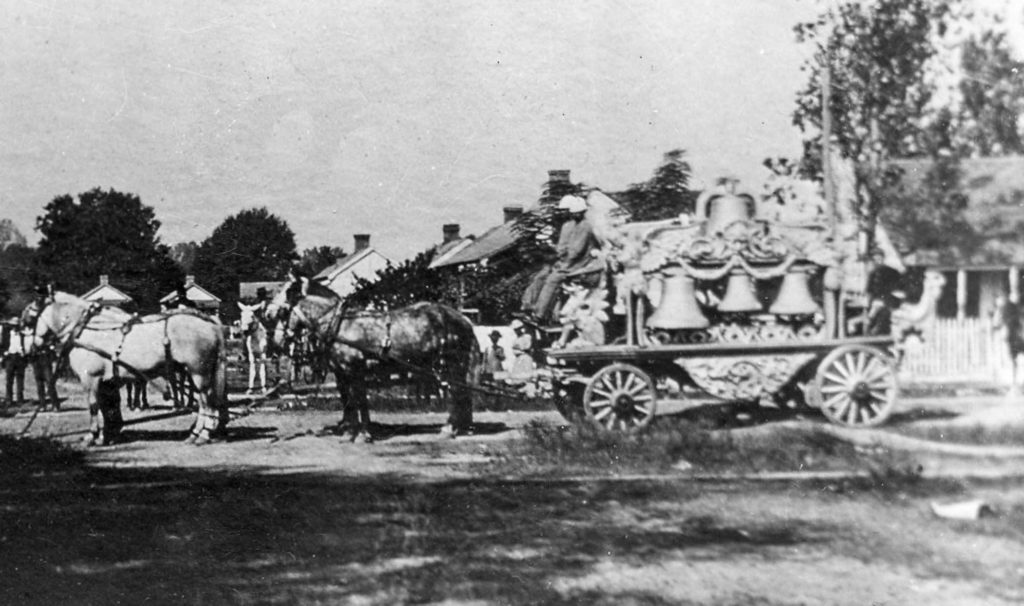 1900 – Enlargement of a Trimpy negative from the Bill Kasiska collection )
1900 – Enlargement of a Trimpy negative from the Bill Kasiska collection )
The bell wagon was now part of a growing Ringling parade. By 1893 their parade featured four bandwagons, one being the Lion & Mirror, several tableaus and floats, a hippo den, a score of cages, an organ wagon, a steam calliope and the relatively new bell wagon. It continued to grow in length and splendor as the Ringlings prospered in the circus business.
Tracing the history of the bell wagon presents no major problems, primarily because it was never sold to another circus. For 92 years it has been a possession of the Ringling show or its descendant organizations, the longest period of single ownership in circus history. Beginning in 1892, the bell wagon was featured in Ringling parades for the next 20 years. A 1910 parade order included it, whereas a 1912 list does not, bracketing the last year of useage as 1910 or 1911. Presumably it was dropped from the show because it served only one purpose, the parade, and could not be used to carry baggage.
The only attempt by the Ringlings to sell the vehicle is recorded in a 1912 sale catalog offering the assets of the defunct 1910-1911 Forepaugh-Sells show. It was described as “One large Tableaux wagon carrying a set of big chime bells as are used in cathedrals and churches; wagon heavily carved; bells to be played by one man.” The price, $700, was the highest in the catalog, $300 higher than the Forepaugh-Sells steam calliope, suggesting the Ringlings would sell it but only if a purchaser was willing to pay a considerable amount for it. The inclusion of the bell wagon on the Forepaugh- Sells list, the only identifiable ex- Ringling show wagon appearing on it, may indicate a transfer in 1911; however, the extensive investigations Richard E. Conover and Fred D. Pfening III conducted concerning the Forepaugh- Sells parade wagons failed to confirm its presence on the 1910-1911 reissue.
Between the 1902 and 1905 tours, the bell wagon was extensively rebuilt, undoubtedly by the Moellers. The great weight of the bells had caused the wagon’s frame to become swaybacked by 1900. The Ringlings took advantage of the repair necessity and extended the scope of the work to implement other changes. In addition to rebuilding the frame, the carvings and woodwork which comprised the driver’s and player’s seats were modified and swapped. The bell keyboard handles were raised, allowing the player to sit completely above the platform. The center bell was lowered and turned ninety degrees and the carved cap which adorned its top was permanently abandoned. These modifications, combined with a lengthening of the platform to over seventeen feet, resulted in a more aesthetically pleasing appearance than the original stubby looking design. Succeeding generations have viewed the wagon in this rebuilt configuration.
From 1911 or 1912 until 1934 the wagon remained in storage and did not make any known public appearances. It was probably stored at the Baraboo winterquarters, in the company of many other retired Ringling wagons. Over the years, Henry Moeller, acting as agent for the Ringlings, sold quite a few of these wagons to other showmen, but none of the buyers secured the famed bell wagon. When the Ringling show played Baraboo in 1933. the year of its golden Anniversary, a few old Ringling and Forepaugh-Sells floats were rolled out of the Ringling barns to the delight of visiting fans. It is surprising that the bell wagon was not displayed at this time. Perhaps there was a lack of motive power to move it, but more than likely it was already gone, transferred to Sarasota at an undetermined date after 1928, the year Ringling-Barnum moved its winterquarters out of Bridgeport, Connecticut to Florida.
The wagon was reportedly at Sarasota when Jess Adkins, manager of the Ringling owned Hagenbeck-Wallace Circus, asked for it and the Five Graces bandwagon to be sent to Peru, Indiana to join his show. Adkins was an adjuster on the Ringling show in the 1910’s, perhaps the reason he was aware of the wagon’s existence. In addition to the usual bandwagons, tableaus and cages found in most circus parades, Adkins’ mammoth 1934 display also included air and steam calliopes, an una-fon and the old Ringling bell wagon, an array unmatched in any previous parade. The wagon was fitted with new wheels, slightly heavier than the originals, and received a coat of paint and a fringe for the player’s canopy. It was a fine and unique addition to the Hagenbeck- Wallace lineup.
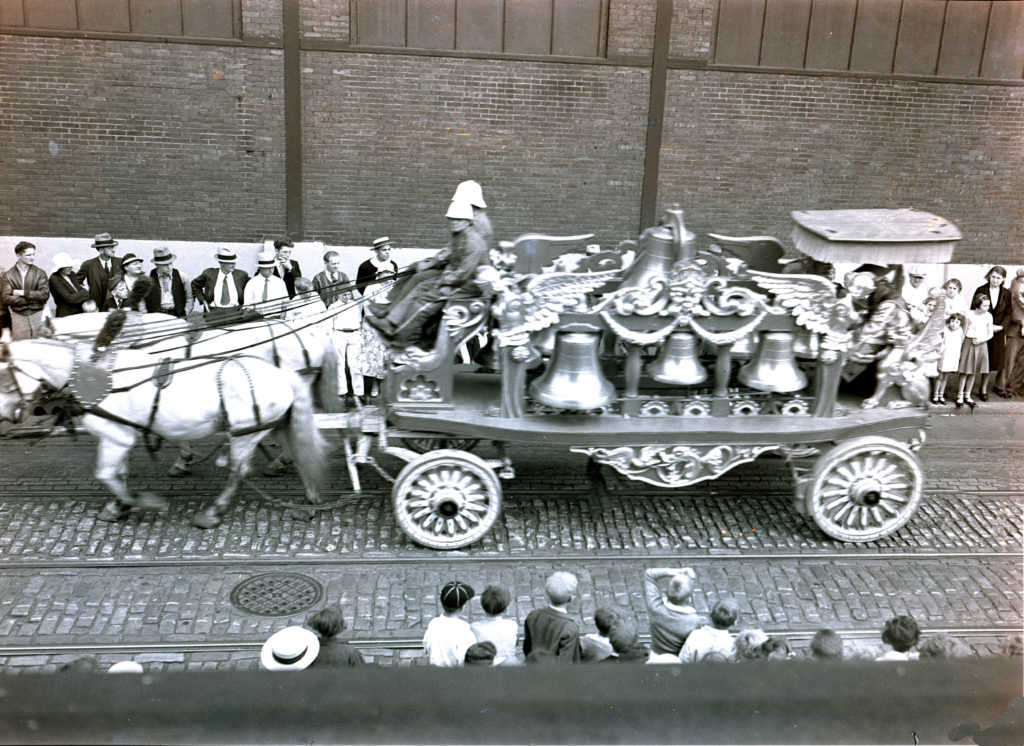 ( 1934 on the Hagenbeck-Wallace Circus in Johnston, PA. – Conover Set # 927 – photo # 717 )
( 1934 on the Hagenbeck-Wallace Circus in Johnston, PA. – Conover Set # 927 – photo # 717 )
Sometime after the 1934 season the bell wagon was returned to Sarasota, there being no need for it on the subsequent versions of Hagenbeck-Wallace, none of which paraded. Photos of the wagon while stored at Peru are non-existant, but Gordon Potter recalls he measured the wagon at the quarters about 1936, indicating it was there for sometime after the 1934 tour.
The wagon did not see further service until 1941, when John Ringling North decided it could be used in the Ringling- Barnum big top spectacles. To facilitate daily use of the bell wagon, the show replaced the wood undergear with steel members and installed dual pneumatic tires in lieu of the wagon wheels. This modification significantly altered the wagon’s appearance, but the fact that it was going to be used insured its survival for a few more years. The bell wagon was utilized in nine out of the next twelve years, absent only between 1943 and 1945. It was used in the show specs, frequently being adorned with artificial decorations inspired by the spec theme.
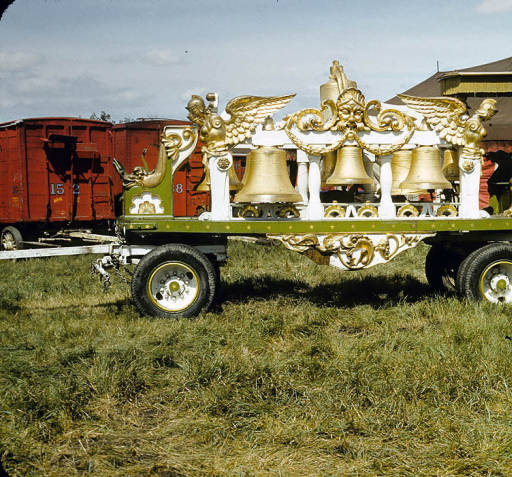 ( 1941 – Sverre Braathen slide – Used with permission from Illinois State University’s Special Collections, Milner Library )
( 1941 – Sverre Braathen slide – Used with permission from Illinois State University’s Special Collections, Milner Library )
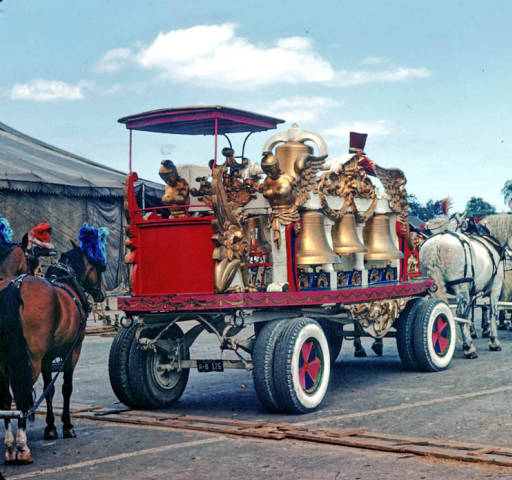
( 1946 – Sverre Braathen slide – Used with permission from Illinois State University’s Special Collections, Milner Library )
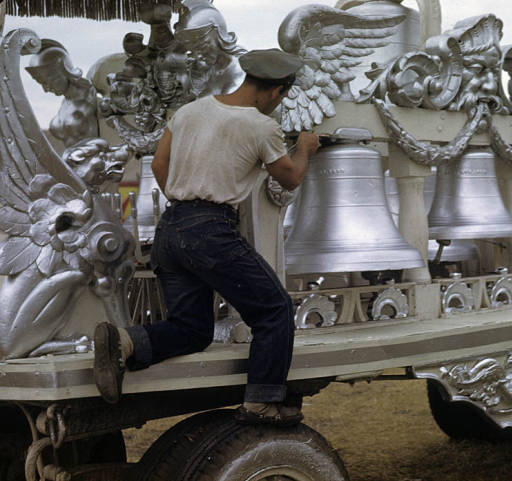 ( 1948 – Sverre Braathen slide – Used with permission from Illinois State University’s Special Collections, Milner Library )
( 1948 – Sverre Braathen slide – Used with permission from Illinois State University’s Special Collections, Milner Library )
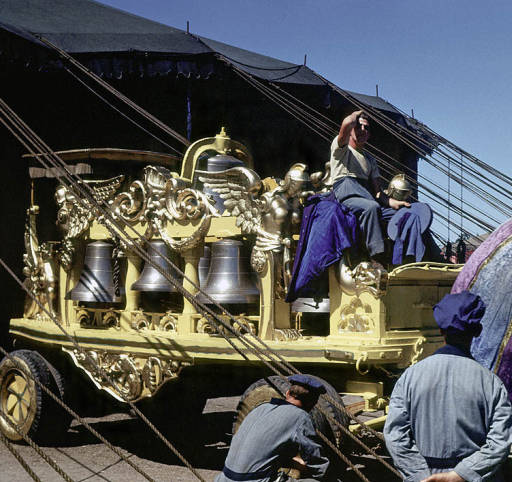 ( 1950 – Sverre Braathen slide – Used with permission from Illinois State University’s Special Collections, Milner Library )
( 1950 – Sverre Braathen slide – Used with permission from Illinois State University’s Special Collections, Milner Library )
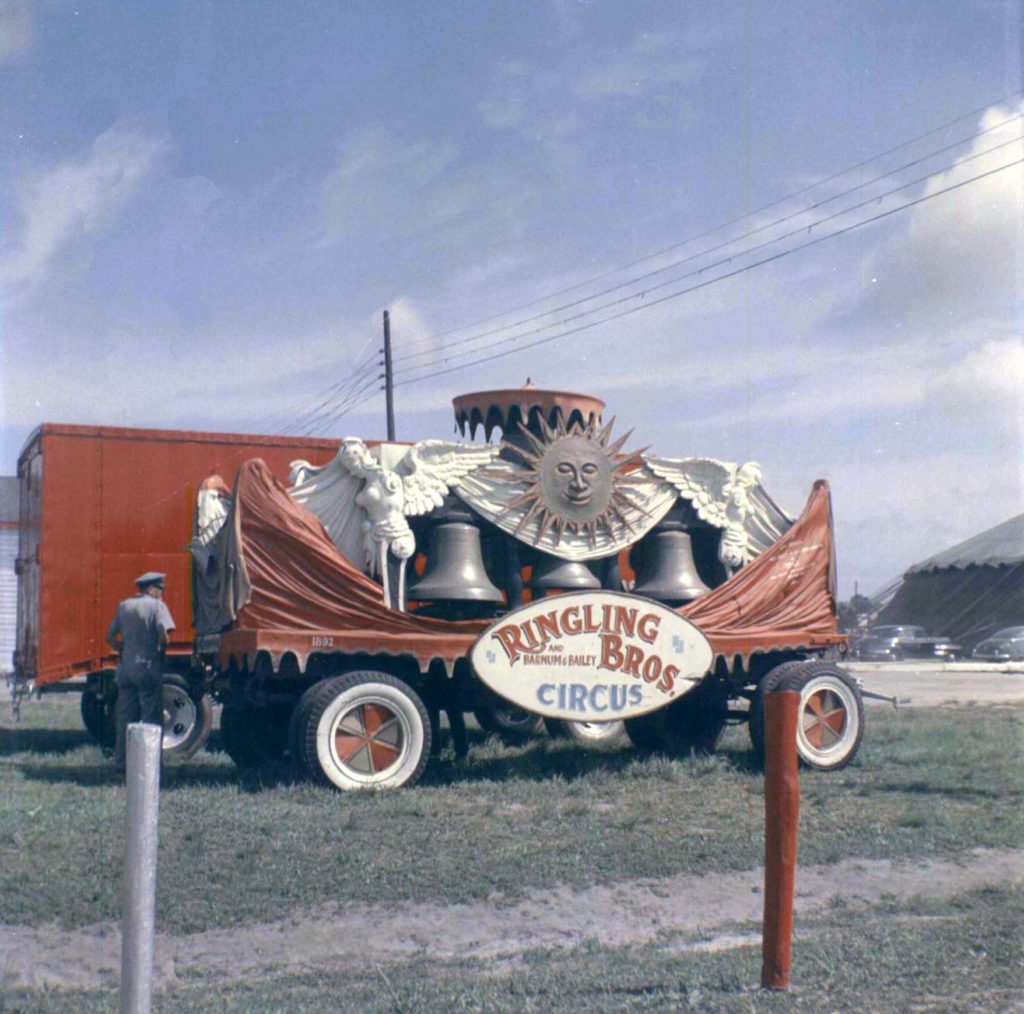 ( 1954 – Sarasota winter quarters – Bernard J. Fleck slide )
( 1954 – Sarasota winter quarters – Bernard J. Fleck slide )
Retired from the road following the 1952 tour, the wagon sat at Sarasota winterquarters until about 1956 when it was placed on exhibit at the Ringling Museum of the Circus. The wagon was a museum feature for twenty three years, reverting back to direct Ringling control in a 1979 agreement. Until it was brought to Baraboo, the bell wagon was stored in a Bradenton, Florida warehouse.
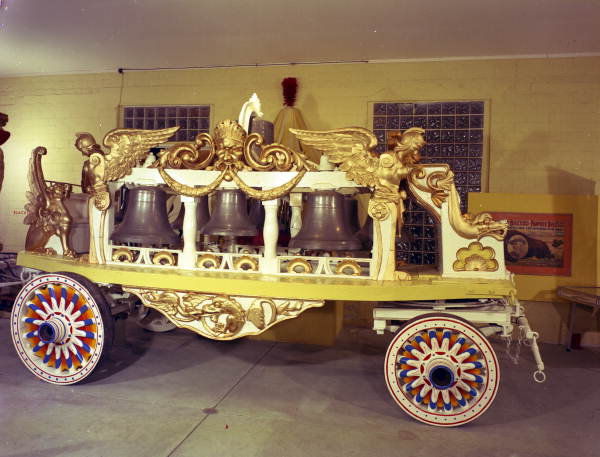 ( Ringling Museums – Conover Photographic collection )
( Ringling Museums – Conover Photographic collection )
The venerable piece of Wisconsin’s circus history returned home on November 30, 1984, when the famed Ringling Bros, bell wagon arrived at Baraboo’s Circus World Museum. The wagon has been placed on loan to the museum via an agreement reached with Kenneth Feld, owner of Ringling Bros, and Barnum & Bailey Circus. Underscoring the priority which his family has placed on preserving the heritage of the Greatest Show on Earth, Mr. Feld has also given a substantial monetary grant to the museum to fund the vehicle’s restoration and other worthy projects. Daily concerts will be given on the wagon at the museum, and it will be featured in the planned 1985 circus parade.
(2) The wagon underwent an extensive re-build under the watchful eye of wagon master, Marv Gauger, and his crew. The bells were all removed from the wagon. the carvings were carefully removed and repaired as needed. The pneumatic wheels were replaced with a set of wooden spoked wheels again. These came from on old logging wagon. The following photos of the re-build were all taken by Marv Gauger and are provided here, courtesy of Stephen T. Flint.
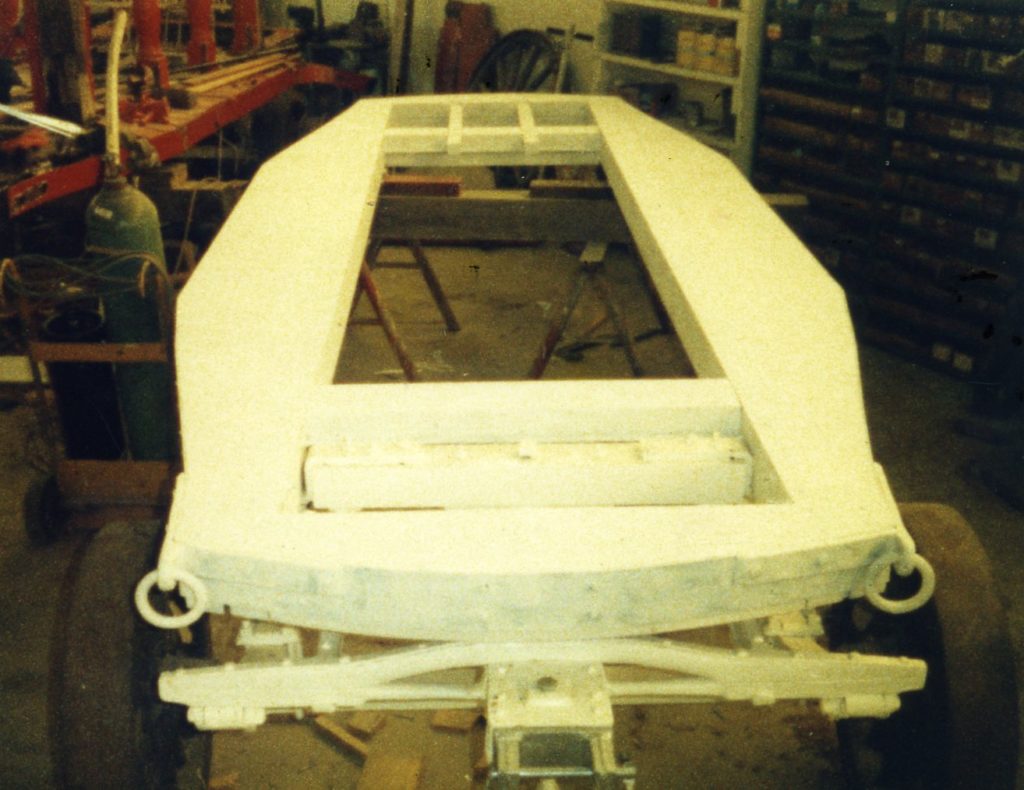
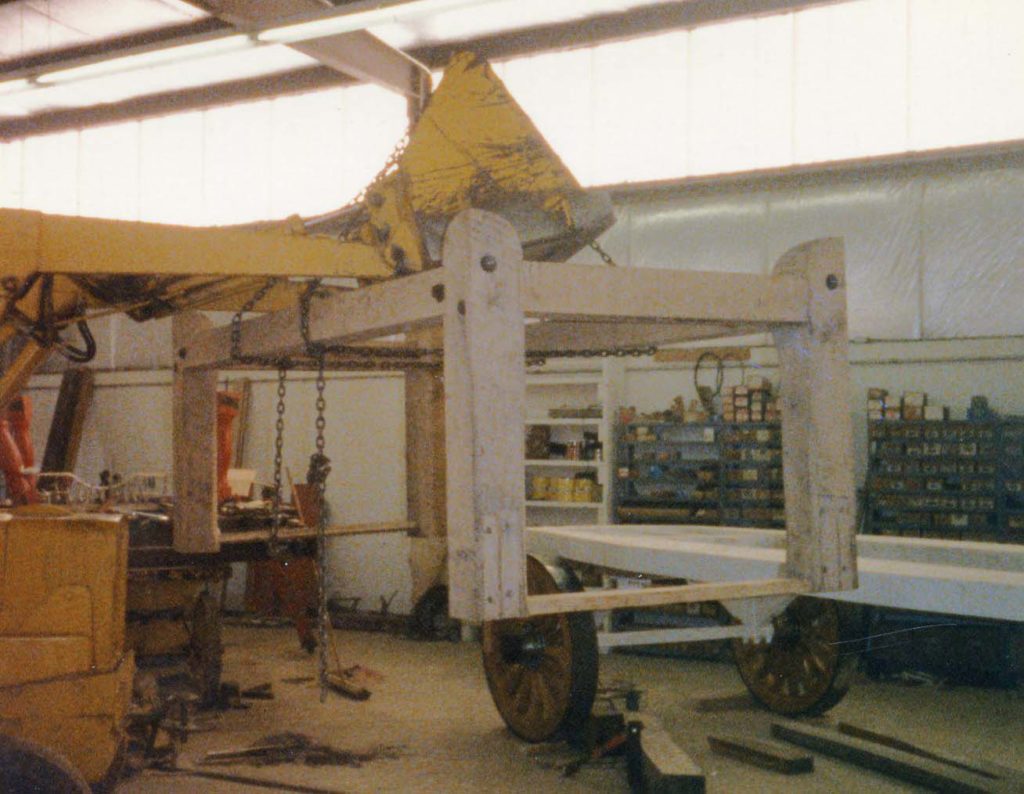
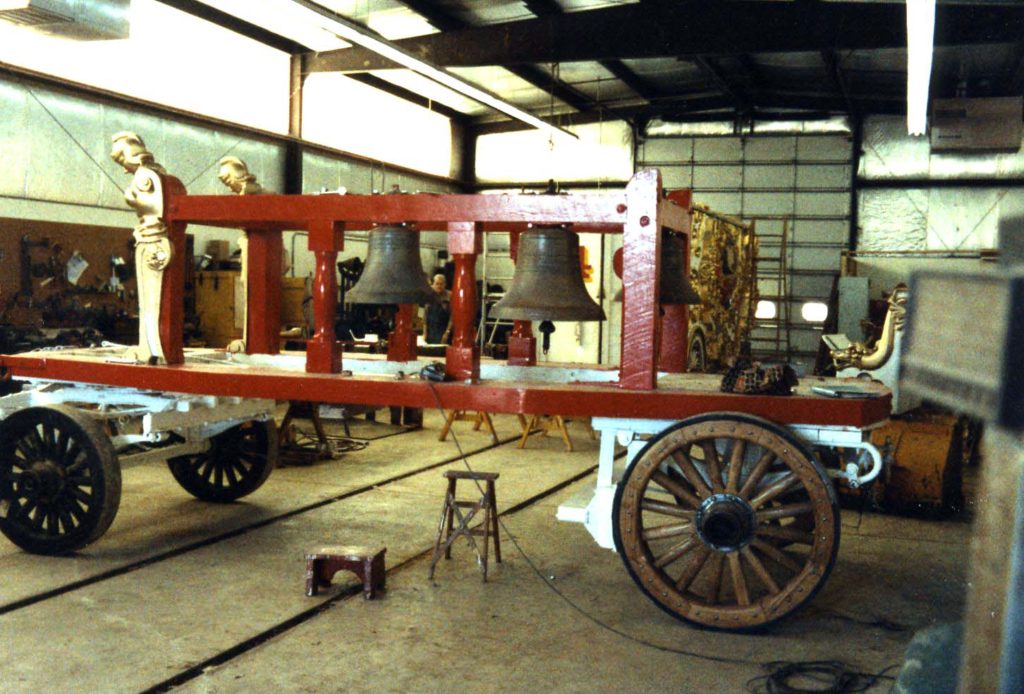
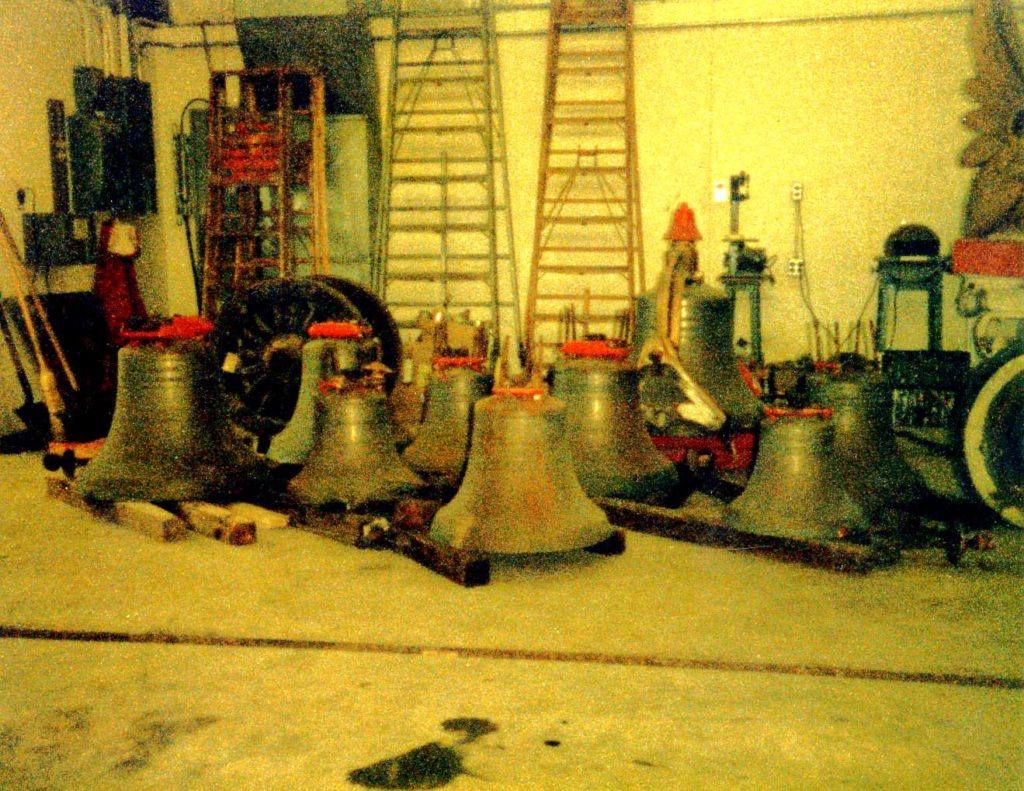
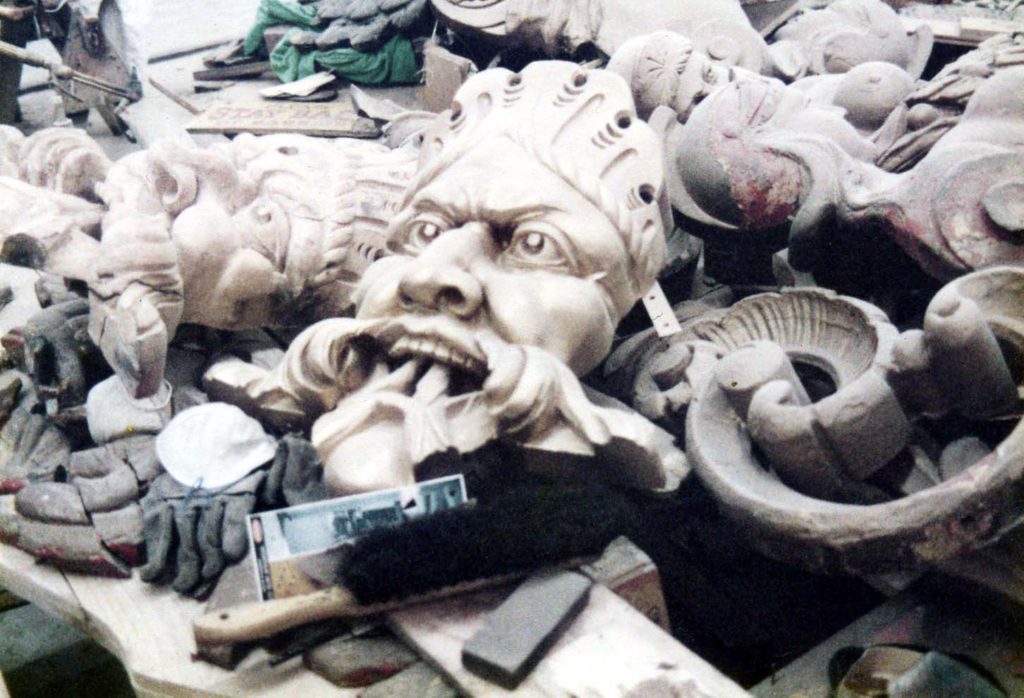
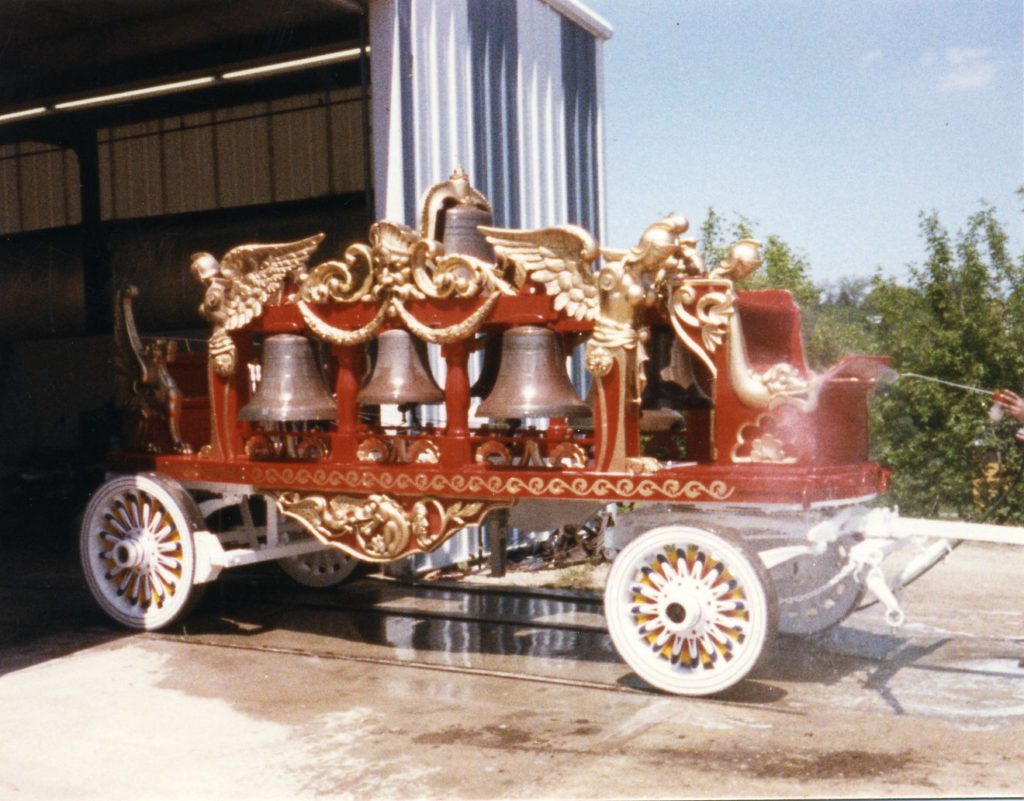
( 1985 – Marv Gauger photos – courtesy of Stephen T. Flint )
In 2013, Kenneth Feld had the wagons on loan at the Circus World Museum returned to his all new winter quarter facility in Ellenton, Florida, where they are part of his circus collection in one of the large rooms of the facility.
(1) Excerpts from the Circus Wagon History File, Bandwagon, Nov. / Dec. 1984, pp. 47-51
(2) Further updates after Fred Dahlinger’s article was published in 1984.
If you have any questions or have more photographic evidence, feel free to contact us at circuswagons@gmail.com
